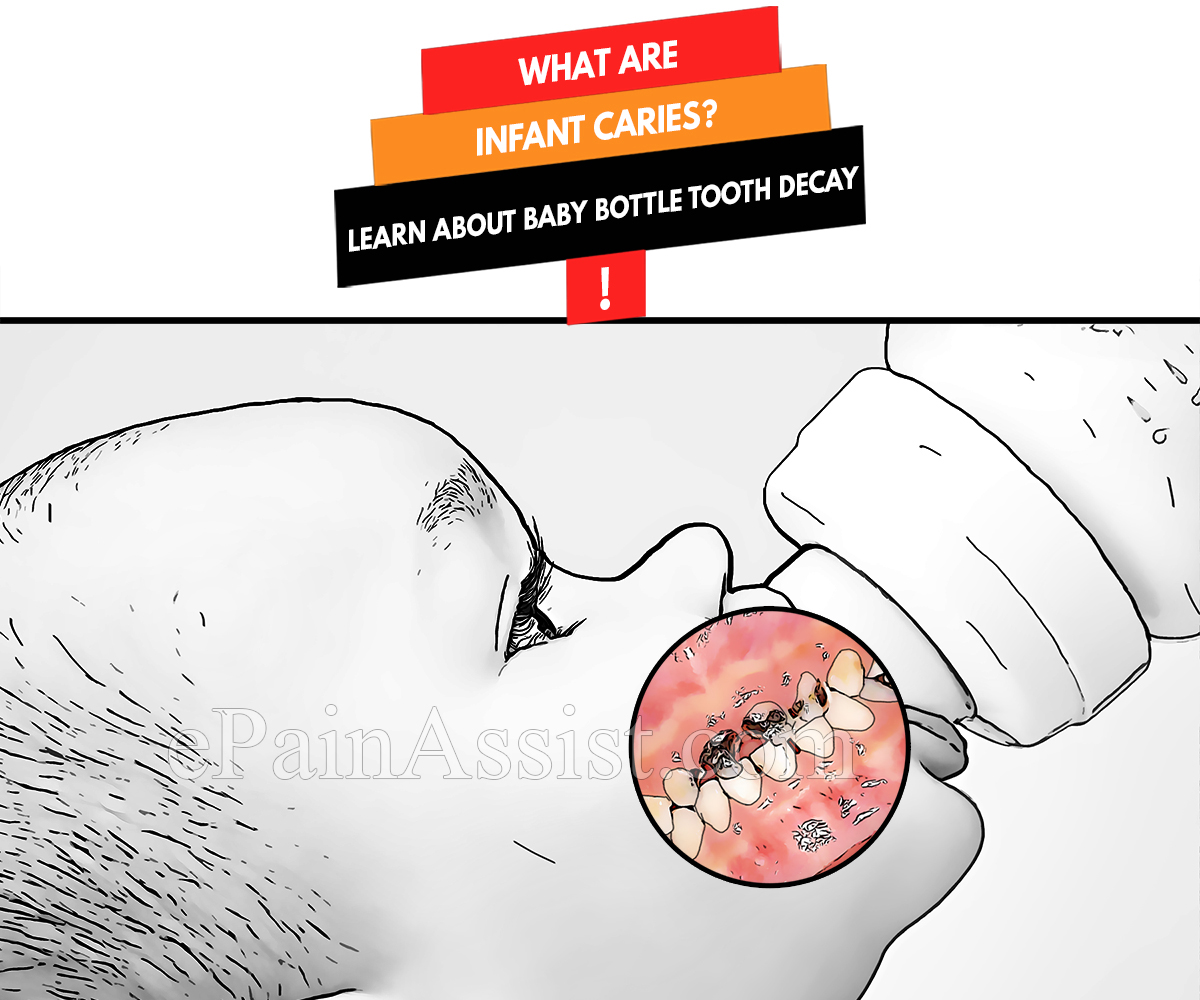Baby bottle tooth decay or infant caries is the decaying of the teeth occurring in infants and young children primarily as a result of bottle feeding. Infant caries or baby bottle tooth decay commonly develops on the upper incisors, which are the front upper teeth. (1) The caries develop because of presence of sugar on the teeth, which can be from formula or milk or any sweet snacks or juices.

What Are The Other Names of Baby Bottle Tooth Decay?
Baby bottle tooth decay is also known as infant caries; bottle mouth caries; nursing caries; early childhood caries; rampant caries; baby bottle caries; milk bottle syndrome; nursing bottle caries and baby bottle syndrome. (1, 4)
What Causes Baby Bottle Tooth Decay?
The primary cause of baby bottle tooth decay or infant caries is continuous contact of the baby teeth with excessive sugar. The bacteria present in the mouth thrive on the sugar and release acid which attacks or destroy the tooth enamel and teeth causing decay or infant caries. (2)
Some of the common sources of sugar for infants are: Infant formula, milk, snacks and juice.
When an infant, while drinking milk from a bottle falls asleep, it can cause baby bottle tooth decay. The use of a sippy cup or bottle for long periods of time leads to formation of a film of sugar on the teeth resulting in decaying of teeth at a rapid pace in children.
What Are the Symptoms of Baby Bottle Tooth Decay?
Baby bottle tooth decay can develop on any of the teeth, but more commonly on the upper incisors or the upper front teeth. The appearance of caries is initially white spots which turn into brown or dark colored spots/stains on the teeth. As there is worsening of the tooth decay, children can have swelling and pain around the affected teeth.
What are the Complications of Baby Bottle Tooth Decay?
Baby bottle tooth decay or infant caries is not to be ignored. Teeth are important for the child to chew, smile and speak. (3) As the child grows in age, adult teeth replace the baby teeth. If the baby bottle tooth decay is not treated or if the child loses the tooth too soon, then infection and pain can occur.
Additionally, baby bottle tooth decay also causes improper development of the child’s teeth and speech problems; and poor eating habits can also occur because of infant caries. Another potential complication of baby bottle tooth decay is that the adult teeth can develop crookedly and cause crowding.
Severe or widespread tooth decay can cause serious such as: crooked adult teeth, chronic pain, acute infections and difficulty or pain with chewing.
How to Prevent Baby Bottle Tooth Decay?
Infant caries or baby bottle tooth decay can be prevented by cleaning the child’s teeth properly and also having awareness of the child’s bottle-feeding habits.
Important Tips for Bottle Feeding
- Never let your child fall asleep with a bottle of milk or juice in their mouth as the sugar will coat the baby’s teeth, which attracts the bacteria and result in caries. (2)
- If your child insists on a bottle when going to sleep then fill the bottle with water. (2)
- Don’t make it a habit for your child to always keep the bottle in their mouth even when they are awake. (2)
Always limit sugary drinks, such as juices to your child. The recommendation of American Academy of Pediatrics is to give a maximum of 6 ounces in a day for young children. (3) Infants below the age of 6 months should not be drinking juice whatsoever.
It is important that your child learns how to drink from a cup instead of a bottle as early as possible. The recommendation of American Dental Association (ADA) is that the child starts drinking from a cup instead of the bottle by its first birthday. (3)
It is better to avoid the use of pacifier completely or limit its use. One should never dip the pacifier in syrup or honey. Honey should never be given to a baby who is below one year of age for whatsoever reason.
- It is important to encourage healthy eating habits in the child from young age.
- It is highly recommended to the wipe the gums of the infant after a feed.
- Start brushing the child’s teeth as soon as they erupt.
- It is a good ritual to set a time for the family to brush their teeth together before bedtime.
- Fluoridated toothpaste can be used when the child can understand that it should not be swallowed. Fluoride helps in combating the acid released by the caries.
- Take your child for regular dentist appointments after they had had their first tooth.
Conclusion
Good oral health habits begin at home with the child’s family. As your baby grows, one can incorporate preventive measures by consulting a pediatric dentist. The first visit to the dentist for your child should be within six months of their appearance of the first tooth. According to the recommendation of the ADA, your child’s first dental consultation should be before their first birthday. (3)
A pediatric dentist helps in better assessment of your child’s teeth and of any potential problems. Regular dentist visits are important after your child has had its first tooth.
- https://www.ncbi.nlm.nih.gov/books/NBK535349/.
- https://www.healthychildren.org/English/ages-stages/baby/teething-tooth-care/Pages/How-to-Prevent-Tooth-Decay-in-Your-Baby.aspx
- https://www.mouthhealthy.org/en/az-topics/b/baby-bottle-tooth-decay
- https://www.frontiersin.org/articles/10.3389/fped.2017.00157/full
